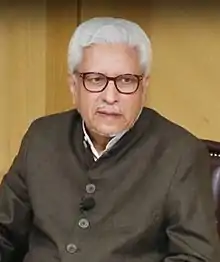| Part of a series on Sunni Islam |
|---|
|
|
The Farahi school (Urdu: فراہی مکتبہ فکر) is the Islamic modernist school of thought originated in the Indian subcontinent. It is named after Hamiduddin Farahi, the student of the modernist Indian Hanafi scholar Shibli Nomani. Unlike, the traditional schools of thoughts, which focus more on Taqlid, it is more based on the self source of reasoning (Ijtihad).[1]
History
Hamiduddin Farahi was born during the times of British Raj. He was a cousin of the famous theologian and historian Shibli Nomani, from whom he learned Arabic.[1] After finishing his studies, He taught in many religious schools, including, Sindh Madressatul Islam University, Karachi, (from 1897 to 1906),[2] Muhammadan Anglo-Oriental College (MAO) and Darul Uloom, Hyderabad. During his stay in Hyderabad, Farahi proposed the idea of establishing a university, in which all religious and modern sciences would be taught in Urdu. He also subsequently went to 'Sara-e-Mir', a town in Azamgarh, where he took charge of the Madrasatul Islah (a reformist school), which was the institution based on the educational ideas of Shibli Nomani and Farahi, The Islamic scholar Amin Ahsan Islahi (who later immigrated to Pakistan), after the partition) was one of them.[3] Islahi influenced another prominent scholar of the era, Javed Ahmad Ghamidi.[1][4]
Notable people
References
- 1 2 3 "The Farahi School Of Thought – Personalities and Contributions". STUDYISLAM.
- ↑ Akram Khan, Muhammad (2013). What is Wrong with Islamic Economics?. Edward Elgar Publishing. p. 195. ISBN 9781782544159.
- ↑ Rehan Ahmad Yousufi (24 August 2018). "Profile of Hamidduddin Farahi". AL-MAWRID HIND FOUNDATION website. Retrieved 5 April 2020.
- ↑ Malik, Jamal (2020). Islam in South Asia. Brill. p. 580. ISBN 978-9004422711.
